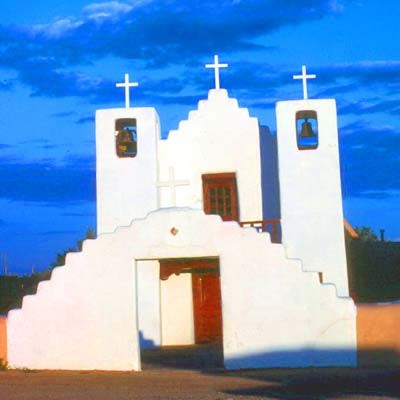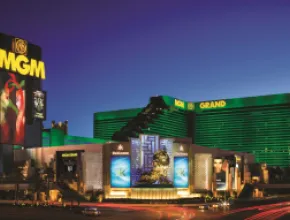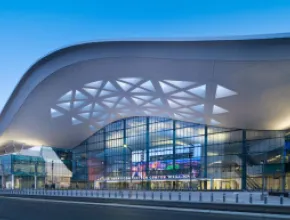Perhaps more than any other destination in the U.S., people are drawn to explore New Mexico’s mysteries, which include alien landing sites, a miraculous staircase and dozens of cities built by ancient Native American cultures. The spiritual and the artistic are close to the surface here, as if the land itself provides inspiration.
“The natural beauty of New Mexico notwithstanding, New Mexico often exists even more vividly in people’s heads and hearts than it does out there on the other side of the car window,” says Mike Stauffer, communications director for the New Mexico Tourism Department.
This is as good an explanation as any for New Mexico’s strange pull.
Many people equate New Mexico with a barren desert: scorching hot and dry as a bone. In fact, a considerable portion of the state is mountainous and heavily forested, with climates striking a pleasant balance year-round between sunshine and coolness.
“People are most often surprised by the mountains and the lakes and streams prevalent throughout New Mexico,” Stauffer says. “Water remains a hot commodity in the Southwest, but New Mexico offers more than its share of water sports, like rafting, fishing, boating, and even scuba diving.”
Even those who come to New Mexico having done their homework and knowing what to expect in terms of weather and attractions come away enchanted.
“It is hard to explain the charm of New Mexico. The big beautiful sky, the friendliness and sincerity of the people here, the abundance of art, the diversity of the faces, the light and the way it plays off of the buildings and the mountains,” says Martha Mondragon-Guerin, director of sales for the Albuquerque CVB. “Our way of life here is slow, calm, beautiful, and sincere. And as for our food, the New Mexico chile and the Native American influences make our food different from what is served in Texas, Arizona, and anywhere else in the Southwest—or the country for that matter.”
New Mexico is an exceedingly diverse state, and it wears its rich cultural heritage on its sleeve. Demographically, it is home to the country’s largest percentage of Hispanic Americans and the second-largest percentage of Native Americans. This melange is undoubtedly part of the secret to the state’s vibrant art communities, uniquely zesty cuisine and unparalleled hospitality.
Tapping into the magic of New Mexico is one of the best ways to create inspiring and memorable agendas for groups.
Albuquerque
New Mexico’s largest city is also its most central. Founded 70 years before the Declaration of Independence was signed, Albuquerque has retained a flavor of being on the frontier, though these days the explorations are scientific in nature; Albuquerque has been home to Sandia National Laboratories and some of the greatest minds in nuclear science since 1949. The city also brims with Native American culture.
“The traditions of the people from this area are full of mysteries,” Mondragon-Guerin says. “Many of the Native American traditions are private ceremonies that are not shared with anyone outside the pueblo. The native people have some traditions that they will share with others, and they will often come and share their music, story telling and traditions with groups.”
Every dance is a prayer, and every element of a costume helps tell the story. Visiting a pueblo or attending a Native American ceremony is a chance to glimpse a way of relating to the world that is both ancient and vibrantly alive. Many pueblos hold regular tours and events that the public are welcome to attend.
Albuquerque’s Indian Pueblo Cultural Center completed an expansion in April, adding classroom space and additional hands-on activities as well as an outdoor event area for dance performances and demonstrations. Facility rentals are available for groups as large as 400.
Although many traditions have been handed down, the meaning of some symbols has been lost to the centuries. A visit to Petroglyph National Monument, which stretches for 17 miles along Albuquerque’s western horizon, reveals more than 25,000 carved images, some with the familiar forms of animals and people, and some strange and inexplicable. The site also contains five volcanic cones and a number of archeological sites.
“There are also scientific mysteries,” Mondragon-Guerin says. “The National Atomic Museum does a great job of telling the story of the Los Alamos. We also work with actors who play the parts of some of those people involved—Einstein, Oppenheimer, etc.—to set up a unique experience for convention attendees.”
The National Atomic Museum will soon be transformed into the National Museum of Nuclear Science and History. The new 30,000-square-foot museum is currently under construction and scheduled to open in spring 2009. The institution will include an outdoor park for aircraft and other large artifacts currently housed at Kirtland Air Force Base. The National Atomic Museum’s current facilities are available for rental and capable of welcoming receptions of 600 and banquets of 100.
Meanwhile, the slice of sky sandwiched between the Sandia Mountains northeast of the city and the Rio Grande Valley boasts unrivaled conditions for hot-air ballooning, another one-of-a-kind experience for attendees.
“Hot-air balloons are not easy to steer, basically you go with the wind,” Mondragon-Guerin says. “In Albuquerque, the balloons can take off from one spot, and by changing altitude, head back to the spot where they took off and land near the launch location. You can see balloons in the early morning sky most days of the year, and more than 700 balloons during the [Albuquerque International] Balloon Fiesta each October. Ballooning is a year-round event, so groups can incorporate this into their conventions.”
More than a half-dozen companies offer hot-air balloon flights and tours.
To learn about the airborne sport on terra firma, groups can head to the Anderson-Abruzzo Albuquerque International Balloon Museum, which opened in 2005 and is available for group events as large as 500 people.
Snow in the high desert may sound like a stretch, but, in fact, the Sandia Mountains offer winter sports at Sandia Peak Ski Area from mid-December through mid-March. There are 30 trails as well as the world’s longest aerial tramway, transporting visitors 2.7 miles over the canyons of Cibola National Forest. High Finance Restaurant and Tavern on Sandia Peak accepts group reservations for 20 or more.
Santa Fe and Taos
The rugged Sangre de Cristo Mountains surrounding Santa Fe and Taos provide opportunities for year-round outdoor recreation, including hiking, biking and skiing, as well as a striking backdrop that has lured artists for decades.
Santa Fe’s charm lies in its ability to surprise visitors, according to Christine Madden, director of sales at the Santa Fe CVB.
“The plaza, the heart of the city, is reminiscent of a more European model for a town with a central plaza, [and it is] surrounded by shops, galleries and museums,” Madden says. “This gives the impression of walking into a small city that is anywhere but the U.S. Geographically, many imagine Santa Fe to be more like Arizona, with flowing sands and towering cactus. In fact, it is a green place three seasons out of the year.”
When attendees head home from Santa Fe, they might find they’ve brought back more than a piece of art or other souvenir.
“So much of Santa Fe is unexpected, the people are so friendly, and the natural setting and relaxed pace is so soothing that visitors can be a little transformed during a visit,” Madden says. “The foreign feel of the city, the savory regional cuisine, the romantic feeling and cozy nature of the many nooks and crannies, and the charming and quaint feel of its 400-year-old historic surroundings all come together to create an experience that’s hard to replicate in New Mexico, much less outside the state.”
Known as “The City Different,” Santa Fe lives up to its nickname. There is public art everywhere, and the city is home to more than 250 art galleries and twisting streets lined with 400-year-old adobe buildings.
Georgia O’Keeffe, one of the most celebrated American painters of the 20th century, was heavily influenced by her love of New Mexico’s landscape. Her crisp, yet abstract interpretations of flowers, still lifes and landscapes are instantly recognizable the world over. Santa Fe’s Georgia O’Keeffe Museum boasts a collection of more than 1,100 of her works as well as thousands of important pieces by other artists of the American modernism movement. The lobby and nine galleries make a graceful and distinctive location for events of up to 200 people.
“Much attention is focused on the higher-profile museums downtown and on Museum Hill,” Madden says. “But SITE Santa Fe in the Guadalupe Street area is a contemporary museum that is one of the country’s best facilities for cutting-edge contemporary art and is often overlooked.”
The 18,000-square-foot facility is also available for rental.
In the center of town, yet tucked away, two hidden sculpture gardens await discovery by modern explorers. They are located next to each other behind the Gerald Peters Gallery and the Nedra Matteucci Galleries, both on Paseo de Peralta.
After locating the city’s secret treasures, visitors can then attempt to solve one of its mysteries. The spiral staircase at the Loretto Chapel, built in 1898, was considered a miracle by the order of nuns associated with the chapel. Legend says that the anonymous carpenter who appeared in answer to their prayers for a builder was actually St. Joseph, patron saint of woodworkers. No one knows what kind of wood was used or how the perfect double helix design is able to stand without visible means of support.
While there are many intriguing sights in Santa Fe, there are also plenty of reasons to get out and explore areas outside the city. The Randall Davey Audubon Center is a picturesque wildlife sanctuary in the foothills of the Sangre de Cristo Mountains. Located on its 135 acres, the historic Randall Davey House began its existence as a stone sawmill in the 18th century. Noted modern art painter Randall Davey converted the sawmill into a home in 1920 and spent the next 44 years living and painting there. Today the stately grounds of the property are available for rental, as are its 1,200-square-foot classroom and a conference room accommodating 17 people.
Taos, located northeast of Santa Fe in the Sangre de Cristo Mountains, is also rich with art and history.
“Taos surprises on many levels,” says Jami McFerren, director of membership and communications at the Taos County Chamber of Commerce. “With more artists per capita than Paris and more nonprofit cultural institutions than cities 10 times its size, Taos invites exploration year-round. Whether the attraction is outdoor recreation or indoor contemplation, Taos draws visitors the first time and charms them into repeat visits for years to come.”
Many cities have an historic district with examples of centuries-old architecture, but Taos boasts the oldest continuously inhabited indigenous community in the continental U.S. The iconic stacked adobe dwellings of Taos Pueblo, located three miles north of town, have been inhabited for more than 1,000 years. Taos Pueblo is a National Historic Landmark as well as a UNESCO World Heritage Site. The pueblo is open daily most of the year, and group rates are available. Visitors can also attend certain feast day celebrations.
Since the 1920s, Taos has been a gathering place for artists seeking inspiration and sharing it in return. The fruits of their labor are displayed in more than 80 art galleries offering creations in every possible medium, from oil and acrylic paintings to pottery, sculpture, leather, jewelry, and unique clothing. Many works pay tribute to the majesty of the surrounding nature and to the mysteries of spiritual exploration. Some galleries are available for special events and receptions.
In fact, Taos is so inspiring that some spirits never get around to leaving.
“A number of the ghosts of Taos were recognized in the book Adobe Angels,” McFerren says. “But visitors can track other-worldly spirits easily by visiting various venues, including the Historic Taos Inn and the Kit Carson Home and Museum.”
Historic Taos Inn is composed of a number of adobe houses built in the 1800s around a central courtyard, which is now the hotel’s lobby. The largest of the adobe houses was owned by Thomas Paul Martin, who was the area’s first doctor. That building is now the acclaimed Doc Martin’s Restaurant, featuring organic ingredients and showcasing native chiles. Among many other luminaries, the property has welcomed Greta Garbo, D.H. Lawrence and Robert Redford. The inn completed a renovation and expansion in summer 2006 that added new guest rooms to the existing historic adobe. The property now has 44 guest units.
There are more wonders waiting outside of Taos’ city limits. Fifteen miles from town is a remarkable community of Earthships, or sustainable homes, in many strange and fanciful shapes. Some are available for nightly rental.
“For more than 30 years now, environmentalists have gathered, researched and built these Earthships, creating a self-sufficient, off-the-grid community where design and function converge in eco-harmony,” McFerren says. “In addition to offering on-site visitor lodging, this community also hosts a variety of workshops and seminars covering everything from the history of their efforts to true work sessions in which participants build Earthship structures.”
Yet another reason to explore beyond the city is the Enchanted Circle, an unforgettable drive with Taos at its hub. In one 86-mile day trip through the mountains, visitors are treated to the sights of 13,000-foot Wheeler Peak, the highest crest in New Mexico; the year-round adventure sports and golf of Angel Fire and Red River villages; the Vietnam Veterans National Memorial; the ghost town of Elizabethtown; the up-and-coming artist colony of Questa; the famous Taos Ski Valley; and the Rio Grande Gorge Bridge, which spans the river at a height of 650 feet.
And if all of this fails to inspire a visitor, perhaps an adjustment is what’s required. Acupuncture, massage, hot springs, hypnotherapy, holistic wellness—Taos is a hot spot for alternative healing, and spas and clinics abound.
Northwestern New Mexico
Farmington is the primary city of northwestern New Mexico, a region crisscrossed by rivers and mountains and rife with points of natural beauty, anthropological interest and scientific innovation. The city of 45,000 is a major hub of the Four Corners area, where the borders of New Mexico, Utah, Arizona, and Colorado meet.
For centuries, the area has been the homeland of many Native American tribes, including the Apache, Hopi, Jicarilla, Navajo, Ute Mountain, and Southern Ute nations. Today groups can visit both existing communities and ancient ruins such as the famous cliff dwellings of Mesa Verde National Park; Bandelier and Aztec Ruins national monuments, which were home to the ancestors of modern-day tribes; and Chaco Culture National Historical Park, an important Puebloan cultural center from A.D. 850 to A.D. 1250 and the most extensive prehistoric ruins in North America.
“These historic sites bring with them a certain mystique as visitors try to imagine the way of life of the ancestral Puebloans who inhabited the ruins,” says Tonya Stinson, marketing manager of Farmington CVB. “Visitors can tour the sites with guides or alone and learn about the rich history of the native people.”
The small community of Los Alamos lends its name to Los Alamos National Laboratory, one of the largest scientific institutions in the world and site of the Manhattan Project, a mission to create the first atomic bomb. Its physicists remain devoted to unraveling the many mysteries of our universe that are still unsolved.
“Los Alamos was picked as the meeting location for some of the greatest minds on the planet, in part due to its creativity-inspiring setting,” says Chelo Rojas, visitor center manager for the Los Alamos Meeting and Visitor Bureau. “This tradition continues, as it is the ideal setting for getting away from it all and for getting your creative juices flowing. You have access to historic venues for your meetings and events as well as venues that have great views.”
Once a secret think tank community, Los Alamos is now open to all.
A visit to the Bradbury Science Museum provides insight into the history of the lab and its groundbreaking research. Group tours are available.
Walking tours of historical Bathtub Row allow the curious to see the former homes of many scientists who played key roles in the advent of the nuclear age. The street is so named because the scarcity of iron during World War II, when the houses were built, made a bathtub a luxury only the wealthiest and most prominent could afford.
Southern New Mexico
As no two chiles taste exactly the same, the primary towns of southern New Mexico—Roswell, Ruidoso, Las Cruces, Mesilla—each possess their own savory flavor. The art and golf of Las Cruces, the Wild West history of Mesilla, the UFO mystique of Roswell, and the white sands and white snow of the mountain town of Ruidoso cover this region with diverse points of interest.
The region is also notable for two unique natural wonders. Carlsbad Caverns National Park contains 113 breathtaking caves created by the dissolving action of sulfuric acid on the limestone rock, and White Sands National Monument comprises 270 square miles of pure, white dunes.
“I have always said that our best-kept secret is our art community,” says John Bulla, convention sales manager for the Las Cruces CVB. “Las Cruces has an extensive array of art ranging from galleries (over 40, and over 200 artists living in Las Cruces), museums, studios, public art, and fine art, to sculptures, paintings, photographs, and historical artifacts. A wonderful variety of performing arts, theater, music, and dance is also available.”
For those who consider the art of a good swing superior to anything hanging on the wall of a gallery, Las Cruces also offers 72 holes of golf year-round.
Whatever attendees choose to do, relaxing is a key part of the experience, according to Bulla.
“There is a feeling you have when you are in Las Cruces,” he says. “You are busy meeting and networking but you don’t feel hurried, and you know you are in a small town but you have the comforts of a big city. Locals call it the ‘Land of Manaña,’ but what it really means is that we take time to enjoy life.”
A perfect day trip from Las Cruces, the sleepy border town of Mesilla has been controlled during its history by Mexico, the U.S. and, during the Civil War, the Confederacy, and it has also been harassed alternately by Apache raiding parties and cattle rustlers. It was a town of riots, shootouts, fiestas, and dances. Today things are much calmer, but not all of the old spirits have been laid to rest. The 150-year-old Double Eagle restaurant is said to play host to the ghosts of tragic lovers Armando and Inez.
In July, the town of Roswell is marking the 60th anniversary of the notorious and storied Roswell Incident with its annual UFO Festival—“the galaxy’s largest,” according the Roswell Chamber of Commerce. The 1947 incident involved the military recovering certain materials claimed by some to be a crash-landed flying saucer. The town also boasts the International UFO Museum and Research Center.
The town of Ruidoso is known for its Ruidoso Downs Race Track and Casino (hosting world-class thoroughbred and quarter horse racing), and it also has a rich Wild West history. The 84-mile Billy the Kid National Scenic Byway, anchored by Ruidoso at its southwestern point, provides a peaceful and lovely backdrop of mountains, rivers and rolling ranchland to colorful and sometimes bloody tales of the Wild West. Located along the byway, Ruidoso Downs is home to the Hubbard Museum of the American West and Billy the Kid Interpretive Center.
Near Ruidoso, attendees can hit the slopes at Ski Apache, owned and operated by the Mescalero Apache tribe. It offers 55 runs and a terrain park from late November through early April. Group rates on rentals and lift tickets are available, and the resort’s Inn of the Mountain Gods has 273 guest rooms, 40,000 square feet of meeting space, 18 holes of golf, and a 38,000-square-foot casino.
For More Info
Albuquerque New Mexico CVB 505.842.9918
www.abqcvb.org
Farmington CVB 505.326.7602
www.farmingtonnm.org
Las Cruces CVB 505.541.2444
www.lascrucescvb.org
Los Alamos Meeting and Visitor Bureau 505.662.8105
www.visit.losalamos.com
Roswell COC 505.623.5695
www.roswellnm.org
Ruidoso Valley COC and Visitors Center 505.257.7395
www.ruidosonow.com
Santa Fe CVB 505.955.6200
www.santafe.org
Taos County COC and Visitor Bureau 505.758.3873
www.taoschamber.com






